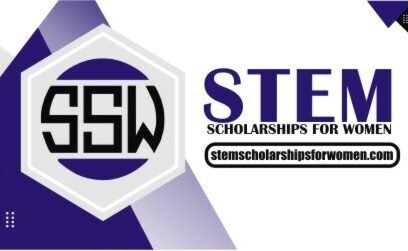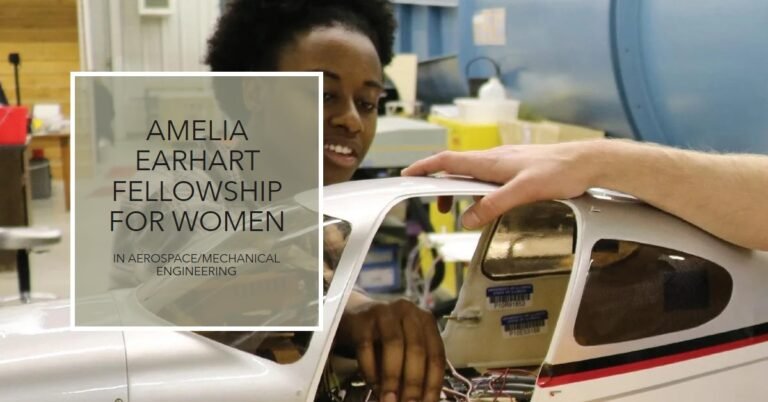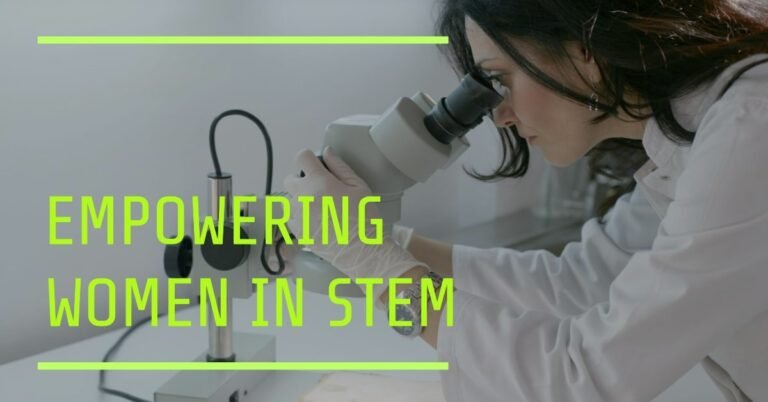How to Find and Apply for Scholarships for Women in STEM
STEM stands for science, technology, engineering, and mathematics, and it is a field that is traditionally dominated by men. According to the UNESCO Institute for Statistics, only 28% of researchers worldwide are women, and only 35% of STEM students in higher education are women. However, there is a growing demand for STEM professionals in the global economy, and many organizations and institutions are committed to increasing the representation and participation of women in STEM.
One of the ways to encourage and support women in STEM is to provide scholarships that can help them pursue their education and career goals. Scholarships are financial awards that do not need to be repaid, and they can cover tuition fees, living expenses, books, equipment, travel, and other costs associated with studying. Scholarships can also provide opportunities for networking, mentoring, internships, and research, which can enhance your academic and professional development.
If you are a woman interested in pursuing a career in STEM, you may be wondering how to find and apply for scholarships that suit your needs and qualifications. In this article, we will show you how to do that, as well as provide some tips and examples to boost your chances of success. By the end of this article, you will have a better understanding of how to find and apply for scholarships for women in STEM, and how to make your application stand out from the crowd.
How to Find Scholarships for Women in STEM
There are many scholarships available for women in STEM, but they may not be easy to find if you do not know where to look. Here are some sources and strategies that can help you find scholarships for women in STEM:
Online databases and search engines:
There are many websites that offer databases and search engines that allow you to find scholarships based on your criteria, such as field of study, level of education, country of origin, country of destination, and other factors. Some examples of these websites are Scholarships.com, Fastweb, Scholarship Portal, and International Scholarships. You can also use Google or Bing to search for keywords such as “scholarships for women in STEM” or “scholarships for women in [specific field]”. However, be careful to verify the legitimacy and credibility of the websites and scholarships that you find, as there may be some scams or outdated information online.
Academic institutions and departments:
Another source of scholarships for women in STEM is your current or prospective academic institution or department. Many colleges and universities offer scholarships for their students, especially for those who demonstrate academic excellence, financial need, leadership potential, or diversity. You can check the websites of your institution or department, or contact the financial aid office, the admissions office, or the faculty members to inquire about the scholarships that they offer or recommend. You can also look for scholarships from other institutions or departments that are related to your field of interest, such as MIT, Stanford, Harvard, or Oxford.
Professional associations and organizations:
Another source of scholarships for women in STEM is the professional associations and organizations that are dedicated to promoting and supporting women in STEM. These associations and organizations often offer scholarships, grants, awards, fellowships, and other forms of financial assistance for their members or applicants who meet their criteria. Some examples of these associations and organizations are The Association for Women in Science (AWIS), The Society of Women Engineers (SWE), The Anita Borg Institute for Women and Technology (ABI), and The Women in Engineering ProActive Network (WEPAN). You can also look for associations and organizations that are specific to your field of interest, such as The American Mathematical Society (AMS), The Institute of Electrical and Electronics Engineers (IEEE), The American Chemical Society (ACS), or The International Federation of Medical Students’ Associations (IFMSA).
Government agencies and programs:
Another source of scholarships for women in STEM is the government agencies and programs that are responsible for funding and supporting education and research in STEM. These agencies and programs often offer scholarships, grants, awards, fellowships, and other forms of financial assistance for students and researchers who meet their criteria. Some examples of these agencies and programs are The National Science Foundation (NSF), The National Institutes of Health (NIH), The Department of Energy (DOE), and The Fulbright Program. You can also look for agencies and programs that are specific to your country of origin or destination, such as The British Council, The German Academic Exchange Service (DAAD), The Japan Society for the Promotion of Science (JSPS), or The Australian Government Department of Education, Skills and Employment (DESE).
Private foundations and corporations:
Another source of scholarships for women in STEM is the private foundations and corporations that are interested in supporting and investing in STEM education and research. These foundations and corporations often offer scholarships, grants, awards, fellowships, and other forms of financial assistance for students and researchers who meet their criteria. Some examples of these foundations and corporations are The Bill and Melinda Gates Foundation, The Google Anita Borg Memorial Scholarship, The Intel Women in Technology Scholarship, and The Palantir Women in Technology Scholarship. You can also look for foundations and corporations that are specific to your field of interest, such as The Boeing Company, The Pfizer Foundation, The IBM Corporation, or The Shell Foundation.
These are some of the sources and strategies that can help you find scholarships for women in STEM, but they are not exhaustive. You can also ask for recommendations from your teachers, mentors, peers, family, or friends who may have experience or knowledge about scholarships for women in STEM. You can also subscribe to newsletters, blogs, podcasts, or social media accounts that provide information and updates about scholarships for women in STEM. The more you research and network, the more likely you will find scholarships that match your needs and qualifications.
How to Apply for Scholarships for Women in STEM
Once you have found some scholarships that you are interested in and eligible for, the next step is to apply for them. The application process may vary depending on the scholarship, but there are some common steps and requirements that you should follow and prepare. Here are some tips and examples to help you apply for scholarships for women in STEM:
Read the instructions and guidelines carefully:
Before you start your application, make sure you read the instructions and guidelines carefully and understand what the scholarship expects from you. Pay attention to the eligibility criteria, the application deadline, the required documents, the submission method, and the selection process. Follow the instructions and guidelines exactly and do not miss any details or requirements. If you have any questions or doubts, contact the scholarship provider or administrator for clarification.
Prepare your documents and materials:
Depending on the scholarship, you may need to prepare and submit various documents and materials to support your application. These may include your academic transcripts, your standardized test scores, your curriculum vitae (CV) or resume, your letters of recommendation, your personal statement, your essays, your portfolio, your research proposal, or your proof of identity, citizenship, or financial need. Make sure you prepare your documents and materials in advance and check them for accuracy, completeness, and quality. Use clear and professional language, format, and layout. Proofread and edit your documents and materials for grammar, spelling, punctuation, and style. Ask someone else to review your documents and materials for feedback and improvement. If possible, use online tools or services to check your documents and materials for plagiarism, readability, and originality.
Write your personal statement and essays:
One of the most important and challenging parts of your application is your personal statement and essays. These are your opportunities to showcase your personality, your motivation, your goals, your achievements, your challenges, your skills, and your potential to the scholarship committee. You should write your personal statement and essays in a clear, concise, and compelling way, using specific examples and evidence to support your claims. You should also tailor your personal statement and essays to the specific scholarship that you are applying for, and address the questions or prompts that they provide. Here are some tips and examples to help you write your personal statement and essays:
- Start with a hook: The first sentence or paragraph of your personal statement or essay should capture the attention and interest of the reader. You can use a hook such as a quote, a statistic, a question, a story, or a personal anecdote to start your personal statement or essay. For example, if you are applying for a scholarship for women in computer science, you could start with a hook like this:
“When I was eight years old, I received my first computer as a birthday gift from my parents. Little did I know that this gift would spark my passion for computer science and change my life forever.”
- Tell your story: The main body of your personal statement or essay should tell your story, and explain why you are interested in and qualified for the scholarship. You should use specific examples and evidence to illustrate your points, and show how your experiences, achievements, challenges, skills, and potential relate to the scholarship’s goals and criteria. You should also demonstrate your enthusiasm, curiosity, creativity, and leadership in your field of interest, and how you have contributed to or plan to contribute to the advancement of women in STEM. For example, if you are applying for a scholarship for women in computer science, you could tell your story like this:
“Ever since I got my first computer, I have been fascinated by the power and possibilities of computer science. I taught myself how to code using online tutorials and courses, and I created my own websites, games, and apps. I also joined the computer club at my school, and participated in various competitions and hackathons, where I learned new skills and met other like-minded students. Through these activities, I realized that computer science is not only a hobby, but also a career that I want to pursue.
However, I also faced some challenges and obstacles as a woman in computer science. I often felt isolated and intimidated by the male-dominated environment, and I encountered some stereotypes and biases that discouraged me from pursuing my passion. I also noticed the lack of representation and role models of women in computer science, both in the media and in the academia. I decided to overcome these challenges and obstacles, and to inspire and empower other women in computer science. I became a mentor and a tutor for younger girls who wanted to learn how to code, and I organized workshops and events to promote computer science among women. I also applied for and received a scholarship from the Google Anita Borg Memorial Scholarship, which enabled me to attend the Grace Hopper Celebration of Women in Computing, where I met and networked with other women in computer science from around the world.
Through these experiences, I learned that computer science is not only a field of study, but also a field of action. I learned that computer science can be used to solve real-world problems, and to create positive social impact. I also learned that computer science can be a tool for empowerment, and for breaking the barriers and stereotypes that limit women in STEM. I want to continue to learn and grow as a computer scientist, and to use my skills and knowledge to make a difference in the world.“
- End with a conclusion: The last sentence or paragraph of your personal statement or essay should summarize your main points, and restate your interest and suitability for the scholarship. You should also thank the scholarship committee for their consideration, and express your enthusiasm and excitement for the opportunity. For example, if you are applying for a scholarship for women in computer science, you could end with a conclusion like this:
“In conclusion, I am very interested and qualified for the scholarship for women in computer science, because I have a strong passion, a solid background, and a clear vision for computer science. I have overcome many challenges and obstacles as a woman in computer science, and I have contributed to and benefited from the community of women in computer science. I want to pursue a degree and a career in computer science, and to use my skills and knowledge to create innovative solutions and positive impact in the world. I am very grateful for the opportunity to apply for this scholarship, and I hope to hear from you soon.”
Get letters of recommendation:
Another important part of your application is your letters of recommendation. These are letters written by people who know you well and can vouch for your academic and professional achievements, skills, and potential. You should ask for letters of recommendation from people who are relevant to your field of interest, such as your teachers, professors, mentors, supervisors, or colleagues. You should also ask for letters of recommendation from people who can provide specific and positive examples and evidence of your performance, character, and suitability for the scholarship. You should also ask for letters of recommendation well in advance, and provide your recommenders with the necessary information and guidance to write their letters. Here are some tips and examples to help you get letters of recommendation:
- Choose your recommenders wisely: You should choose your recommenders carefully, and make sure they are qualified, credible, and supportive of your application. You should also choose your recommenders based on the requirements and preferences of the scholarship. For example, some scholarships may require or prefer letters of recommendation from academic sources, while others may require or prefer letters of recommendation from professional sources. You should also choose your recommenders based on their relationship and experience with you, and their ability and willingness to write a strong and personalized letter of recommendation for you. For example, if you are applying for a scholarship for women in computer science, you could choose your recommenders like this:
“I have chosen three recommenders who can attest to my academic and professional achievements, skills, and potential in computer science. They are:
- Dr. Jane Smith, my computer science professor at the University of Lagos, who taught me several courses and supervised my final year project. She can speak to my academic excellence, my research skills, and my passion for computer science.
- Mr. John Doe, my manager at the XYZ Company, where I worked as a software engineer intern for six months. He can speak to my technical skills, my teamwork skills, and my problem-solving skills.
- Ms. Mary Jones, my mentor and the founder of the Women in Tech Nigeria, a non-profit organization that promotes and supports women in technology. She can speak to my leadership skills, my community involvement, and my vision for women in STEM.”
- Ask your recommenders politely and respectfully: You should ask your recommenders politely and respectfully, and explain why you are asking them for a letter of recommendation. You should also ask your recommenders at least a month before the application deadline, and give them enough time to write their letters. You should also ask your recommenders in person or by phone, if possible, and follow up with an email. For example, if you are applying for a scholarship for women in computer science, you could ask your recommenders like this:
“Dear Dr. Smith,
I hope this email finds you well. I am writing to ask you if you would be willing to write a letter of recommendation for me for the scholarship for women in computer science, offered by the ABC Foundation. The scholarship is for women who want to pursue a master’s degree in computer science at a top university in the UK, and it covers the full tuition fees, living expenses, and travel costs.
I am asking you for a letter of recommendation because you have been one of my most influential and inspiring professors in computer science. You have taught me several courses, such as Data Structures and Algorithms, Artificial Intelligence, and Machine Learning, and you have supervised my final year project, which was on developing a chatbot for mental health support. You have also encouraged and supported me to participate in various competitions and conferences, such as the ACM International Collegiate Programming Contest and the IEEE Women in Engineering International Leadership Conference. You have seen my academic excellence, my research skills, and my passion for computer science, and I believe you can provide a strong and positive endorsement of my application.
The application deadline for the scholarship is January 31, 2024, and the letter of recommendation should be submitted online through the scholarship portal. I have attached the scholarship guidelines and my CV for your reference. If you agree to write a letter of recommendation for me, I will provide you with more details and information to help you write your letter.
I would greatly appreciate it if you could write a letter of recommendation for me, as it would make a significant difference in my application. Please let me know if you are willing and able to do so, and if you have any questions or concerns. Thank you very much for your time and consideration.
Sincerely, Your name“
- Provide your recommenders with the necessary information and guidance: You should provide your recommenders with the necessary information and guidance to write their letters of recommendation. You should provide them with the following information:
- The name and description of the scholarship that you are applying for, and the link to the scholarship website or portal.
- The deadline and the method of submission for the letter of recommendation.
- The instructions and guidelines for the letter of recommendation, such as the length, the format, the content, and the tone.
- The criteria and the goals of the scholarship, and the qualities and skills that they are looking for in the applicants.
- Your personal information, such as your name, your contact details, your academic background, your professional experience, your achievements, your awards, your publications, your extracurricular activities, your interests, and your goals. – Your specific reasons and examples of why you are interested in and qualified for the scholarship, and how the scholarship will help you achieve your goals. – Any other information that you think is relevant and important for your application, such as your challenges, your strengths, your weaknesses, your values, your passions, or your vision.
You should also provide them with some guidance on how to write their letters of recommendation, such as the following tips:
- Use a formal and professional tone, and address the letter to the scholarship committee or the specific person in charge of the scholarship.
- Start the letter with an introduction, where you state your name, your position, your relationship with the applicant, and the purpose of the letter.
- Write the main body of the letter, where you provide specific and positive examples and evidence of the applicant’s academic and professional achievements, skills, and potential, and how they relate to the scholarship’s criteria and goals. You should also highlight the applicant’s enthusiasm, curiosity, creativity, and leadership in their field of interest, and how they have contributed to or plan to contribute to the advancement of women in STEM.
- End the letter with a conclusion, where you summarize your main points, and restate your endorsement and recommendation of the applicant. You should also thank the scholarship committee for their consideration, and provide your contact details in case they have any questions or concerns.
- Proofread and edit the letter for grammar, spelling, punctuation, and style. Ask someone else to review the letter for feedback and improvement. If possible, use online tools or services to check the letter for plagiarism, readability, and originality.
You should also thank your recommenders for their time and effort, and keep them updated on the status of your application. You should also send them a thank-you note or a gift after you receive the result of your application, and let them know the outcome and your next steps.
Submit your application and follow up:
The final step of your application is to submit your application and follow up with the scholarship provider or administrator. You should submit your application before the deadline, and make sure you receive a confirmation email or message that your application has been received. You should also keep a copy of your application and your documents and materials for your reference. You should also follow up with the scholarship provider or administrator after you submit your application, and check the status and the progress of your application. You should also be prepared for any interviews, tests, or additional requirements that the scholarship may require. You should also be patient and respectful, and wait for the result of your application.
FAQs
Here are some frequently asked questions and answers about scholarships for women in STEM:
Q: How competitive are scholarships for women in STEM?
A: Scholarships for women in STEM are very competitive, as there are many applicants who are interested in and qualified for the scholarships. However, this should not discourage you from applying, as there are also many scholarships available, and each scholarship has its own criteria and goals. You should do your best to research and apply for the scholarships that match your needs and qualifications, and to make your application stand out from the crowd.
Q: How much money can I get from scholarships for women in STEM?
A: The amount of money that you can get from scholarships for women in STEM depends on the scholarship that you are applying for, and the costs and expenses associated with your education and research. Some scholarships may cover the full or partial tuition fees, while others may cover the living expenses, books, equipment, travel, and other costs. Some scholarships may also provide additional benefits, such as opportunities for networking, mentoring, internships, and research. You should check the details and the terms and conditions of the scholarship that you are applying for, and plan your budget accordingly.
Q: How can I improve my chances of getting scholarships for women in STEM?
A: There are many ways that you can improve your chances of getting scholarships for women in STEM, such as the following tips:
- Start your research and application early, and apply for multiple scholarships that suit your needs and qualifications.
- Follow the instructions and guidelines of the scholarship exactly, and do not miss any details or requirements.
- Prepare your documents and materials in advance, and check them for accuracy, completeness, and quality.
- Write your personal statement and essays in a clear, concise, and compelling way, using specific examples and evidence to support your claims.
- Get letters of recommendation from people who know you well and can vouch for your academic and professional achievements, skills, and potential.
- Submit your application before the deadline, and make sure you receive a confirmation email or message that your application has been received.
- Follow up with the scholarship provider or administrator after you submit your application, and check the status and the progress of your application.
- Be prepared for any interviews, tests, or additional requirements that the scholarship may require.
- Be patient and respectful, and wait for the result of your application.
Conclusion
In conclusion, scholarships for women in STEM are a great way to encourage and support women who want to pursue a career in STEM. There are many scholarships available for women in STEM, but they may not be easy to find or apply for. In this article, we have shown you how to find and apply for scholarships for women in STEM, as well as provided some tips and examples to boost your chances of success. We hope that this article has been helpful and informative, and that you will be able to find and apply for the scholarships that suit your needs and qualifications. We wish you all the best in your education and career goals, and we hope that you will join and contribute to the community of women in STEM.



![Have you ever dreamt of building bridges, designing robots, or shaping the future with innovative technology? If you're a Black woman with a passion for STEM (Science, Technology, Engineering, and Math) fields, the C.L. Scholarship of Black Women in Engineering could be your key to unlocking those dreams! This amazing scholarship recognizes the challenges faced by Black women in engineering and provides much-needed financial support to help them excel. This blog post is your one-stop shop for everything C.L. Scholarship! We'll delve into the scholarship's objectives, eligibility requirements, application process, and benefits. So, grab a cup of coffee, settle in, and get ready to take the first step towards an incredible engineering journey! What is the C.L. Scholarship of Black Women in Engineering and What Are Its Objectives? The C.L. Scholarship of Black Women in Engineering, offered by Bold.org, is a beacon of hope for aspiring Black female engineers. It aims to bridge the gap in gender and racial representation within the engineering field by providing financial assistance to deserving students. Here's a breakdown of the scholarship's core objectives: • Empowering Black Women in Engineering: This scholarship breaks down financial barriers, allowing Black women to pursue their engineering aspirations. • Promoting Diversity in STEM: By supporting Black women in engineering, the scholarship fosters a more inclusive and innovative STEM landscape. • Celebrating Excellence: It recognizes and rewards the academic achievements and dedication of Black female engineering students. The C.L. Scholarship is more than just money; it's a powerful symbol of change and a commitment to building a future where Black women are celebrated leaders in the engineering world. Who is Eligible to Apply for the C.L. Scholarship and What Are the Requirements? So, you're wondering if you qualify for this amazing scholarship? Here's a breakdown of the eligibility criteria to help you assess your fit: • Race and Gender: The scholarship is open to African American female high school seniors or undergraduate students currently enrolled in an accredited engineering program. • Academic Performance: A minimum GPA of 3.0 or higher is required to demonstrate your academic commitment. • Passion and Drive: This scholarship seeks passionate individuals who are demonstrably enthusiastic about pursuing a career in engineering. Remember: Meeting the minimum requirements is just the first step. A strong application will showcase your academic achievements, your passion for engineering, and your future goals in the field. How Much is the C.L. Scholarship Worth and What Are the Benefits? The C.L. Scholarship of Black Women in Engineering offers financial support to ease the financial burden of pursuing an engineering degree. While the specific amount awarded may vary depending on the scholarship fund and the number of recipients, it can significantly contribute to your educational expenses. Beyond the financial benefits, the C.L. Scholarship offers a valuable boost to your academic journey: • Recognition and Validation: Being chosen for this scholarship is a prestigious honor that acknowledges your talent and dedication. • Increased Visibility: The scholarship can open doors to networking opportunities and potential future internships or job placements. • A Supportive Community: Becoming a C.L. Scholar can connect you with a network of inspiring Black women in engineering, providing valuable mentorship and support. The C.L. Scholarship is an investment in your future, offering both financial and professional advantages that can propel your engineering career to new heights. Available Courses The C.L. Scholarship of Black Women in Engineering is open to students pursuing a variety of engineering disciplines. Some of the most popular engineering fields include: • Civil Engineering: Design and build infrastructure projects like bridges, dams, and roads. • Chemical Engineering: Develop and improve chemical processes used in various industries. • Electrical Engineering: Design, develop, and test electrical equipment and systems. • Computer Engineering: Combine computer science and engineering principles to create hardware and software systems. • Mechanical Engineering: Design, develop, and test mechanical devices and systems. This list is not exhaustive, and many other exciting engineering specializations exist. With the C.L. Scholarship, you can pursue the engineering field that most ignites your passion! When is the Deadline to Apply for the Scholarship and How to Submit the Application? The application deadline for the C.L. Scholarship of Black Women in Engineering typically falls on May 31st. However, it's always a good practice to double-check the exact deadline date on the scholarship's official webpage at Bold.org closer to the application period. This ensures you have the most up-to-date information and avoids any last-minute surprises. Here's a quick guide on how to submit your application: 1. Visit the Bold.org website: Head over to the Bold.org scholarships page and locate the C.L. Scholarship of Black Women in Engineering. 2. Review the application requirements: Carefully read through the scholarship criteria and application instructions to ensure you meet all the necessary requirements. 3. Gather your application materials: This typically includes transcripts, a resume or CV, a letter of recommendation, and an essay about a Black woman who inspires you and how their story impacts your engineering aspirations. 4. Submit your application: Once you've compiled all the required materials, submit your complete application electronically through the Bold.org platform. Remember: A stellar application goes beyond just meeting the minimum requirements. Take your time, showcase your passion for engineering, highlight your academic achievements, and craft a compelling essay that demonstrates your unique voice and goals. Where Can Applicants Find More Information and Contact Details? For the latest information and updates regarding the C.L. Scholarship of Black Women in Engineering, you can visit the following resources: • Bold.org Scholarship Page: The official webpage on Bold.org provides detailed information about the scholarship, eligibility criteria, application process, and deadlines [1]. • Contact Bold.org: If you have any questions or require further clarification, you can reach out to Bold.org directly through their website contact form. Don't hesitate to seek clarification! Understanding the scholarship details fully strengthens your application and ensures you present yourself in the best possible light. FAQs: Frequently Asked Questions about the C.L. Scholarship Here are some frequently asked questions (FAQs) regarding the C.L. Scholarship of Black Women in Engineering: 1. I'm not a US citizen, can I still apply? The C.L. Scholarship doesn't specify citizenship requirements. However, it's always best to double-check the eligibility criteria on the Bold.org website for the latest updates. 2. What if my GPA is slightly below the 3.0 minimum? A strong application can overcome a minor GPA shortfall. Highlight your academic achievements, showcase your passion for engineering, and demonstrate a clear upward trend in your grades. 3. When will I know if I've been awarded the scholarship? Scholarship winners are typically announced in late June following the application deadline. 4. Can I use the scholarship for a community college program? The scholarship is primarily intended for students enrolled in accredited engineering programs at four-year universities. 5. Is there a specific engineering field I should pursue to qualify? The C.L. Scholarship is open to students pursuing a variety of engineering disciplines. Choose the field that aligns with your interests and career goals. 6. What happens if I win the scholarship? Scholarship recipients receive financial aid to support their educational expenses. They may also gain access to networking opportunities and a supportive community of Black women in engineering. 7. How can I make my application stand out? Craft a compelling essay that showcases your unique voice, passion for engineering, and future goals. Highlight your academic achievements and extracurricular activities that demonstrate your dedication and leadership potential. Conclusion The C.L. Scholarship of Black Women in Engineering is a powerful force for change, empowering Black women to pursue their dreams in the exciting world of engineering. If you're a passionate and dedicated Black woman with a thirst for knowledge and a desire to make a difference, this scholarship could be the key that unlocks your potential. So, don't wait! Research the scholarship thoroughly, gather your application materials, and craft a compelling application that demonstrates your talent and dedication. The future of engineering is waiting for bright minds like yours!](https://stemscholarshipsforwomen.com/wp-content/uploads/2024/03/Celebrating-Black-Women-in-Engineering-768x402.jpg)



